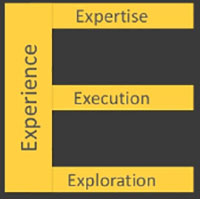What employee type or shape are you?

- Blog
- Career progression
- Professional development
- Skills
- AgileSHIFT
August 13, 2020 |
3 min read
- Blog
- Career progression
- Professional development
- Skills
- AgileSHIFT
In an era of adaptation and better ways of working in the context of continuous performance improvements, people have inevitably expanded their skill set and capabilities. Much of this change has stemmed from the shifting of roles and organizational structures in response to a VUCA (volatility, uncertainty, complexity and ambiguity) dynamic. AgileSHIFT® called it the impact of technology on the development of skills. These skill sets and capabilities helps define the employee type or shape across a capability and maturity spectrum. The journey begins with:
I-shaped people characterized by a single speciality or area of expertise. They demonstrate limited general knowledge of different disciplines and prefer to work in one single job type. That is why they are depicted with the letter "I" which represents their deep knowledge and experience in a single speciality or domain.
T-shaped people have vertical (specialized) skills but also horizontal (general) knowledge in other disciplines. IDEO's former Chief Executive Tim Brown coined the term 'T-shaped person’. This is in reference to IDEO's method of hiring people for both their breadth and depth of experience. In comparison to I-shaped people (depicted by those with very narrow expertise), T-shaped people have broad skills across multiple fields of knowledge or discipline (the horizontal part of the T), but also deep expertise in one particular speciality or domain (the vertical piece).
Pi-shaped people are multifaceted with skills that resemble the Greek letter pi (π), a term coined by Ashley Friedlein, CEO and co-founder of Econsultancy. Pi-shaped people have evolved from the T-shape into one denoted by broad mastery of general knowledge but also deep functional or domain expertise in two or more knowledge areas. People with multiple areas of expertise provide even greater flexibility to the team, particularly to the organizations that have limited people resources.

M-shaped people have evolved from being Pi-shaped into those who possess multiple specialties (the vertical part of the M). From a resource management perspective, a person with one or more specialties are more adaptable than someone with a single speciality (I-shaped person) or even Pi-shaped. As such, each additional speciality changes the letter “M” to a comb. That is, where a person possesses more than three specialties to resemble a comb shape.

E-shaped is a new paradigm shift, where people actively demonstrate a combination of four characteristics - Experience, Expertise, Exploration and Execution to form the letter E. E-shaped people who demonstrate the breadth and depth of knowledge have expanded their knowledge to include tangible (execution i.e. proven ability to deliver) and intangible (exploration i.e. proven ability towards continuous improvement) specialities. This implies the person has both vision and granular detail to make a discernible difference to the organization reminiscent of being a best practice practitioner in whatever domain or competency.
X-shaped people have a higher degree of self-awareness, adaptive capacity and the competencies to thrive in the future. Similar to the self-actualisation in Maslow's Hierarchy of Needs, this employee type refers to the pinnacle of individual capability and competency. That is, X-shaped people demonstrate uniquely human skills that are grounded in empathy and purpose. They move from domains of knowledge to a constant state of learning, continually adapting to the environment. People with X-shaped skills have deep expertise in specialities (or knowledge area) as well as strong leadership skills and credibility.
In summary, what each shape shows is the evolution that a person can take to expand not only their general knowledge across multiple disciplines but also that innate drive to learn (horizontal) and to be an expert (vertical) in more than one speciality. In the future, career changes will not be rare; they will be part of everyone’s role, even in the same organization and team.